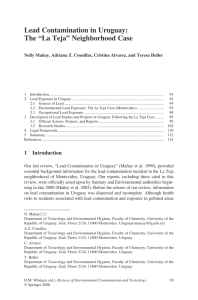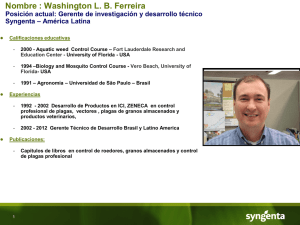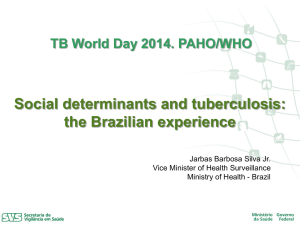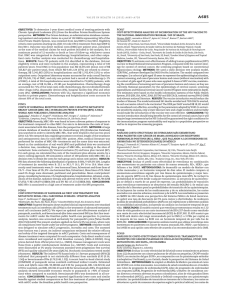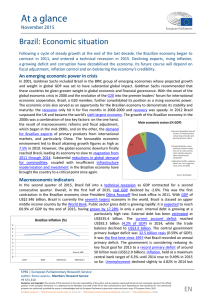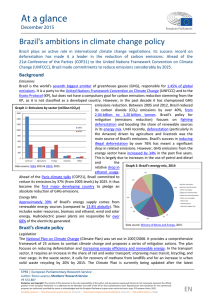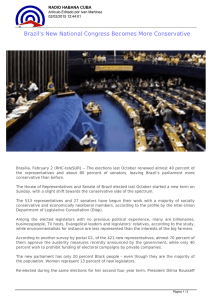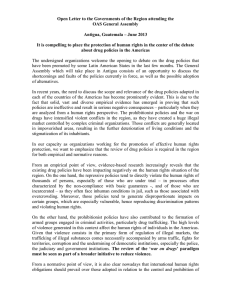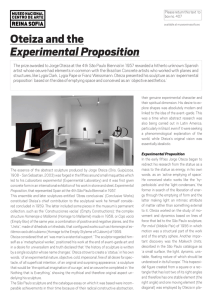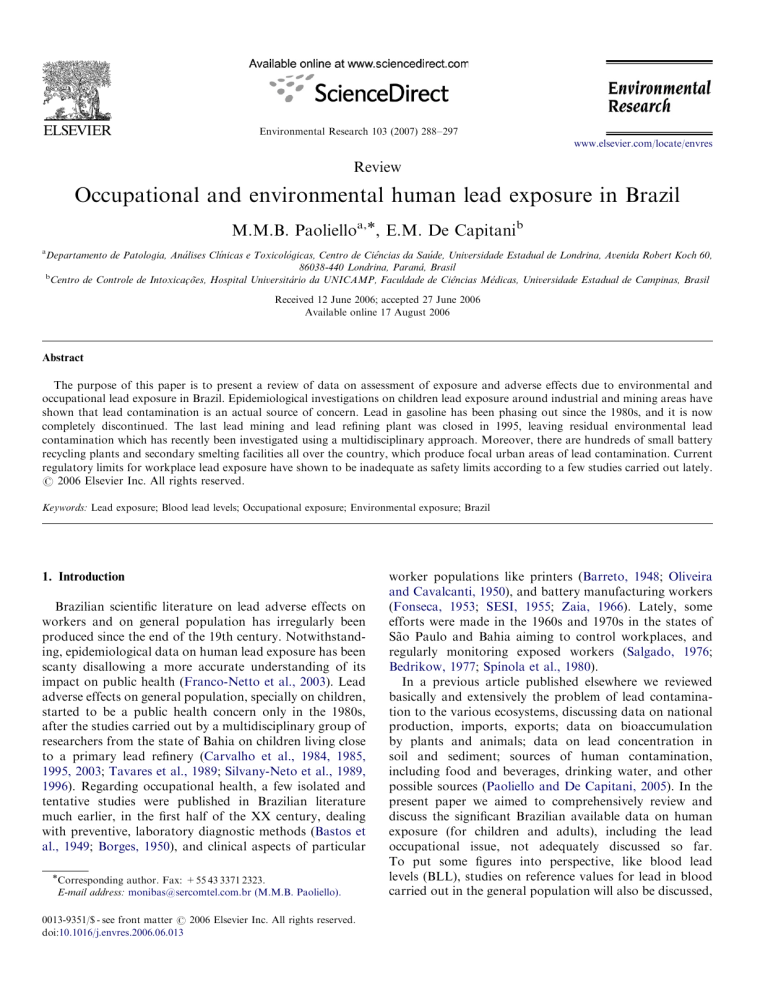
ARTICLE IN PRESS Environmental Research 103 (2007) 288–297 www.elsevier.com/locate/envres Review Occupational and environmental human lead exposure in Brazil M.M.B. Paolielloa,, E.M. De Capitanib a Departamento de Patologia, Análises Clı´nicas e Toxicológicas, Centro de Ciências da Saúde, Universidade Estadual de Londrina, Avenida Robert Koch 60, 86038-440 Londrina, Paraná, Brasil b Centro de Controle de Intoxicac- ões, Hospital Universitário da UNICAMP, Faculdade de Ciências Médicas, Universidade Estadual de Campinas, Brasil Received 12 June 2006; accepted 27 June 2006 Available online 17 August 2006 Abstract The purpose of this paper is to present a review of data on assessment of exposure and adverse effects due to environmental and occupational lead exposure in Brazil. Epidemiological investigations on children lead exposure around industrial and mining areas have shown that lead contamination is an actual source of concern. Lead in gasoline has been phasing out since the 1980s, and it is now completely discontinued. The last lead mining and lead refining plant was closed in 1995, leaving residual environmental lead contamination which has recently been investigated using a multidisciplinary approach. Moreover, there are hundreds of small battery recycling plants and secondary smelting facilities all over the country, which produce focal urban areas of lead contamination. Current regulatory limits for workplace lead exposure have shown to be inadequate as safety limits according to a few studies carried out lately. r 2006 Elsevier Inc. All rights reserved. Keywords: Lead exposure; Blood lead levels; Occupational exposure; Environmental exposure; Brazil 1. Introduction Brazilian scientific literature on lead adverse effects on workers and on general population has irregularly been produced since the end of the 19th century. Notwithstanding, epidemiological data on human lead exposure has been scanty disallowing a more accurate understanding of its impact on public health (Franco-Netto et al., 2003). Lead adverse effects on general population, specially on children, started to be a public health concern only in the 1980s, after the studies carried out by a multidisciplinary group of researchers from the state of Bahia on children living close to a primary lead refinery (Carvalho et al., 1984, 1985, 1995, 2003; Tavares et al., 1989; Silvany-Neto et al., 1989, 1996). Regarding occupational health, a few isolated and tentative studies were published in Brazilian literature much earlier, in the first half of the XX century, dealing with preventive, laboratory diagnostic methods (Bastos et al., 1949; Borges, 1950), and clinical aspects of particular Corresponding author. Fax: +55 43 3371 2323. E-mail address: [email protected] (M.M.B. Paoliello). 0013-9351/$ - see front matter r 2006 Elsevier Inc. All rights reserved. doi:10.1016/j.envres.2006.06.013 worker populations like printers (Barreto, 1948; Oliveira and Cavalcanti, 1950), and battery manufacturing workers (Fonseca, 1953; SESI, 1955; Zaia, 1966). Lately, some efforts were made in the 1960s and 1970s in the states of São Paulo and Bahia aiming to control workplaces, and regularly monitoring exposed workers (Salgado, 1976; Bedrikow, 1977; Spı́nola et al., 1980). In a previous article published elsewhere we reviewed basically and extensively the problem of lead contamination to the various ecosystems, discussing data on national production, imports, exports; data on bioaccumulation by plants and animals; data on lead concentration in soil and sediment; sources of human contamination, including food and beverages, drinking water, and other possible sources (Paoliello and De Capitani, 2005). In the present paper we aimed to comprehensively review and discuss the significant Brazilian available data on human exposure (for children and adults), including the lead occupational issue, not adequately discussed so far. To put some figures into perspective, like blood lead levels (BLL), studies on reference values for lead in blood carried out in the general population will also be discussed, ARTICLE IN PRESS M.M.B. Paoliello, E.M. De Capitani / Environmental Research 103 (2007) 288–297 as well as some aspects of the Brazilian regulatory acts on lead concentration limits in workplaces and in the environment. Papers were searched using basically Medline and scientific literature databases hosted by Virtual Health Library (BVS-BIREME-PAHO-WHO; http://www.bireme.br/) which permits access to LILACS, a specific Latin America database for South American publications in Portuguese and Spanish. Environmental assessment reports from local Environmental Agencies were also consulted. All papers containing detailed information on sampling procedures and methods used were quoted and discussed. Current Brazilian production of metal lead (8832 ton in the year 2000) represents 0.003% of the global production, and it has clearly declined over the last years. Actually it represents only 8.1% of the total amount of lead that is consumed in the country per year. All mineral production is exported because local lead refining stopped in 1996. Nowadays, around 90% of the total national consume of lead in the country comes from recycling activities. However, it is estimated that about 2 million used batteries are annually lost to that recycling effort (Franco-Netto et al., 2003). The main consumers of lead in the country are the lead-acid battery producers (80%), representing 88,000 ton (figures from 1999), followed by oxides and pigments (12%), and the electric and electronic sectors (soldering and alloys) with 8% (Brasil, 2001). 2. Studies on blood lead reference values Although this is a matter of considerable concern, Brazil does not have, as a health public policy, any regular program for measuring BLL in the general population. A few particular studies tried to determine BLL as reference values in some cities. In São Paulo, the biggest industrialized urban center in the country, the only such study was done and published in 1981 (Fernı́cola and Azevedo, 1981). At that time, lead was still added to gasoline all over the country. BLL were measured by flame atomic absorption spectrometry (Perkin Elmer 360) in three different adult population subgroups from a small rural area, an urban population without any occupational or industrial environmental contact with lead, and another subgroup living near a lead recycling plant. Using inclusion and exclusion criteria in a non-random voluntary sample, they selected 56 adult from both sexes in the rural area and found mean BLL of 11.2 mg/dL (SD ¼ 5.6; range ¼ 3.2–27.2); in a group of 100 adults from the urban area, a mean of 12.4 mg/dL (SD ¼ 4.8; range ¼ 2.8–25.7); and in a group of 54 residents of the area around the lead recycling plant, a mean BLL of 20.5 mg/dL (SD ¼ 5.7; range ¼ 9.2–33.1) (Fernı́cola and Azevedo, 1981). Men had significantly higher levels compared to women in the three subgroups. No other similar studies were carried out in São Paulo so far. 289 In another study carried out by Paoliello et al. (2001), in a non-exposed population in Londrina, state of Paraná, a non random sample of 538 adults was selected using inclusion and exclusion criteria. Blood lead median value obtained was 5.7 mg/dL (range ¼ 1.2–13.7) with no significant difference between sexes. Londrina is a dynamic, but poorly industrialized city with the economy based mainly on specialized services. At the time of the study, lead had already been withdrawn from gasoline for the last 10 years. Table 1 shows the results of these two studies compared with blood lead reference values from other countries. Rosalém (2004) studying the possible relationship of environmental lead exposure and reproductive outcome in women from São Paulo, did not find any significant correlation with BLL. No other studied risk factors showed any positive correlation. The author found mean BLL in 190 pregnant women with healthy babies of 2.39 mg/dL (SD ¼ 2.53), and 2.71 mg/dL (SD ¼ 5.86) in 190 women with miscarriage. 3. Studies on ALA-D activity reference values Delta-aminulevulinic acid dehydratase (ALA-D) is an enzyme strongly inhibited by lead in human organism. Its activity levels can be a good index of early lead biochemical adverse effect, mainly in low levels exposure situations as seen in general population. In a study aiming to establish reference values for delta-aminolevulinic acid dehydratase activity (ALA-D) in the general population of southern Minas Gerais, De Siqueira et al. (2003) studied 113 blood samples from 56 adult males and 57 adult females. The mean value obtained was 54.5 mM/min/L erythrocytes (SD ¼ 9.8; 95% CI ¼ 52.7–56.4). According to the authors these results were higher than any other results published elsewhere. Age, gender, drinking, or smoking did not significantly interfere with ALA-D results. In 1981, Fernı́cola and Azevedo, in the study of BLL in São Paulo, performed ALA-D activity measurements in the same adult population. They found mean ALA-D of 47.1 mM/min/L erythrocytes (SD ¼ 9.8; range ¼ 20.8–67.6) in the rural area; mean of 38.4 mM/ min/L erythrocytes (SD ¼ 7.1; range ¼ 19.1–58.7) in the urban area; and mean of 30.5 mM/min/L erythrocytes (SD ¼ 12.1; range ¼ 14.5–60.3) in the residents of the urban area around the lead recycling plant (Fernı́cola and Azevedo, 1981). 4. Lead in gasoline It is known that many factors can influence BLL in adult population, such as age, sex, ethnic group, food habits, alcohol consumption, smoking, hobbies, and place of dwelling. Besides that, sources of lead exposure are always changing in location and intensity along the time, making reference values a temporary definition (Gerhardsson et al., ARTICLE IN PRESS 290 M.M.B. Paoliello, E.M. De Capitani / Environmental Research 103 (2007) 288–297 Table 1 Reference values for blood lead level (BLL) in adult population of several places in the world compared to municipalities of São Paulo and Londrina, Brazil Place São Paulo, state of São Paulo, Brazil Londrina, state of Paraná, Brazil n Italy Lombardia region, north of Italy Luca, Italy Denmark 63 37 520 219 301 2861 3806 203 959 299 100 United States 4320 Taiwan, China 5913 5913 316 209 202 72 2330 (total) Italy (several places) Korea (several regions) China Japan District of Florence, Italy Jordan 746 Average BLL(mg/dL) a 14.2 (men) 9.3a (women) 5.5b(total) 5.6b (men) 5.4b (women) 15.30c (men) 10.0c (women) 13.8a 15.77a 8.4a 5.6a (men) 4.6a (women) 2.6b — 7.0c 8.28a 6.36b (men) 5.09b (women) 5.67b (women) 3.21b(women) 9.35c (men) 6.25c (women) 1.96a Standard deviation Reference 4.3 3.9 — Fernı́cola and Azevedo (1981) — — 4 — 4.1 2.7 2.9 — — Morisi et al. (1989) Paoliello et al. (2001) Apostoli and Alessio (1990) Minoia et al. (1990) Montesanti et al. (1995) Grandjean (1992) apud Gerhardsson et al. (1996) NHANES III (1988–1991) Liou et al. (1996) 5.39 1.44 1.45 — — — Zhang et al. (1997) Zhang et al. (1997) Donni et al. (1998) — Dabbas and Al-Zoubi (2000) Yang et al. (1996) Source: Paoliello and De Capitani (2005) (modified). a Aritmetic mean. b Geometric mean. c Median. 1996). It is well recognized that BLL have been decreasing among people living in countries where some measure aiming to control or ban lead in gasoline has been adopted. In addition, international publications reveal a tendency towards reducing lead in the atmosphere in several countries. Such reductions have been reported in the United States (Muntner et al., 2005), Canada, Germany, Norway, United Kingdom (WHO, 1995), Chile (SánchezCortez et al., 2003), Costa Rica (Sánchez-Molina and Rojas-Carrión, 2003), and Mexico (Flores and Albert, 2004). According to Paoliello and De Capitani (2005) in Brazil, phasing out of lead in gasoline started as a consequence of the National Anhydrous Ethanol Program, a strategic program launched in 1975 in an attempt to diminish oil imports. Through this program, engine changes were performed aiming to use anhydrous ethanol as automotive fuel. As a consequence, a substantial percentage of ethanol was also added to regular gasoline to boost its octane rating, replacing tetraethyl lead. Ethanol itself does not need lead to boost its octane rating. However, only in 1979 a regulatory disposition (Resolution 14/79), issued by the Petroleum National Council (CNP), defined that gasoline type-C (the one used for ordinary terrestrial, and aquatic vehicles) could not have any tetraethyl lead, being replaced by up to 22% of its volume by ethanol. The maximum allowed addition of 0.8 ml/L of tetraethyl lead would be to restrict to gasoline types A and B (high octane rating) for exclusive use of the Air Forces, and commercially distributed in the states of Acre, Rondônia, Amapá, and Roraima (Resolution 14/79 and Technical Regulation 04/79 of the Petroleum National Council—Ministry of Mining and Energy (CNP-MME), 4 September 1979). In 1982, a new resolution (Resolution 15/82) modified the former 1979 technical regulation, allowing a maximum of 0.8 ml/L of tetraethyl lead also in the ordinary gasoline, retroacting the decision of 1979 (Resolution 15/82 and Technical Regulation 04/79 Rev. I, CNP-MME, 30 November 1982). After those resolutions, there has not been another specific legislation forbidding tetraethyl lead use as gasoline additive, but since 1993 its use became totally unnecessary when it was established the obligation to add 22% of ethanol (Paoliello and De Capitani, 2005). 5. Body lead burden and adverse effects in adults 5.1. Adult exposure in workplaces As showed above, occupational lead exposure in Brazil occurs mainly in lead-acid battery producing and recycling plants. The lead-acid battery producing sector officially employs around 8000 workers all over the country, producing 11,500,000 batteries per year (Brasil, 2002; ARTICLE IN PRESS M.M.B. Paoliello, E.M. De Capitani / Environmental Research 103 (2007) 288–297 291 Table 2 Epidemiological studies on lead workers in Brazil Reference Design and worker population Observations Mendes (1974) Cross sectional Lead miners and lead smelting workers in three plants Alves and Terra (1983) Cross sectional 93 tetraethyl lead workers in Rio Grande do Sul Cross sectional 62 lead workers in three plants Cross sectional 52 lead smelting workers in Bahia Mean of BLL Exposed group 1: 93.6 mg/dL Control group 1: 52.6 mg/dL Exposed group 2: 56.2 mg/dL Control group 2: 48.2 mg/dL Mean of BLL ¼ 35.2 mg/dL 8.6% with BLL above 60 mg/dL Mean of BLL: 52, 39, and 69 mg/dL Monteiro et al. (1985) Pinto de Almeida et al. (1987) Alvarez-Leite et al. (1989) Cross sectional 223 lead workers Melo Mattos et al. (1994) Cross sectional 1520 blood samples from lead workers from the metropolitan area of Belo Horizonte, Minas Gerais Cross sectional 166 workers exposed to lead 60 control workers Dos Santos et al. (1994) Silva et al. (1995) Cordeiro et al. (1996a) Cordeiro et al. (1996b) Demarchi et al. (1999) Araújo et al. (1999) Caldeira et al. (2000) Silva et al. (2000) Case study Cross sectional 20 lead battery workers compared with 20 controls Cross sectional 20 lead battery workers compared with 20 controls Cross sectional 116 lead battery workers Cross sectional 22 lead battery workers Cross sectional 82 workers exposed to lead, Rio de Janeiro Cross sectional Two groups of exposed workers Silva (2001) Cross sectional 47 lead battery workers Menegotto and Paoliello (2001) Cross sectional 62 lead battery workers De Capitani et al. (2004) Clinical trial 19 workers from various kinds of lead industries Mean of BLL: 64.1 mg/dL Mean of ZPP: 212.1 mg/dL Mean of BLL (control group): 25.5 mg/dL No significant differences in ALA-U results corrected or not by density 70% of the samples above 40 mg/dL 35% of the samples above 60 mg/dL Higher diastolic arterial pressure in the exposed group (Po0:05). Higher median activity of urinary NAG in the exposed group (Po0:001) with good correlation with BLL (Po0:001) but not with arterial pressure Hand muscles paralysis (finger’s common extensor) Neuropsychological signs of radial Neuropathy in the exposed group (P ¼ 0:06) Neurobehavioral alterations in the exposed group (P ¼ 0:02) 58.6%: BLLo40 mg/dL 23%: BLL between 41 and 60 mg/dL 18.1%: BLL460 mg/dL 55% of workers with BLL above 25 mg/dL Mean of BLL: 61.5 mg/dL BLL (mean): 17.3 mg/dL (group 1) BLL (mean): 61.5 mg/dL (group 2) Significant correlations: ALA-U and BLL (group 1 r ¼ 0:739; group 2 r ¼ 0:902) BLL (mean): 44.52 mg/dL ALA-U (mean): 14.25 mg/g C Pb-U: 7.33 mg/g C Significant correlations found: Pb-U and BLL (r ¼ 0:677); ALA-U and BLL (r ¼ 0:654); ALA-U and Pb-U (r ¼ 0:852) BLL (mean): 45.0 mg/dL Control group—BLL (mean): 7.0 mg/dL. Statistical differences between BLL levels and hematological parameters when compared with control group Mean of BLL: 90.0 mg/dL BLL: blood lead level. Pb-U: urine lead level. ALA-U: delta-aminolevulinic acid in urine. ZPP: zincoprotoporphyrin. Franco-Netto et al., 2003). Those figures do not compute the informal contingent of employees working illegally in small recycling shops, without any workplace control or biological monitoring enforcement. Monitoring of workers BLL commenced in late 1960s in São Paulo, Southeastern Brazil, where a specialized medical service, linked to the industries owners association, provided technicians and equipment to the task. Reports on workers monitoring were published as internal reports (SESI, 1955) or non-scientific publications (Zaia, 1966). In spite of that, no parenteral chelating treatment was offered at that time, and workers were simply kept out of work ARTICLE IN PRESS 292 M.M.B. Paoliello, E.M. De Capitani / Environmental Research 103 (2007) 288–297 until BLL came down, when they usually returned to the same work conditions. Table 2 summarizes the studies on occupational exposure published since the 1970s. None of the studies can represent the real situation of lead occupational exposure due to the lack of good sampling design. Most of the studies have a cross-sectional design investigating different outcomes of a small part of the exposed population. In spite of that, they present a kind of an average portrait of BLL in that industrial sector. Mendes (1974, 1977) investigated lead miners and lead smelting workers in the biggest Brazilian company located in Bahia. Using the dithizone extraction method for spectrophotometric analysis of lead in blood, he found very high levels, even in the worker control population living nearby the primary smelting plant. The mean of BLL in the smelting plant workers was 93.6 mg/dL (SD ¼ 33.2), compared to 52.6 mg/dL (SD ¼ 23.0) in metal workers not involved in the smelting plant at least in the last 2 years. Miners of galena (lead sulfide ore) showed mean BLL of 56.2 mg/dL (SD ¼ 22.3) compared to 48.2 mg/dL (SD ¼ 24.2) in a group of agriculture workers of the same region (Mendes, 1974). These results probably show a systematic over estimation of BLL intrinsic to the dithizone method. In 1976, Salgado published an extensive review paper discussing analytical methods for lead exposure monitoring advocating the use of atomic absorption spectrometry as a key method for lead in blood (Salgado, 1976). Monteiro et al. (1985), studying superoxide dismutase (SOD) and glutathione peroxidase levels in lead workers, found BLL means of 52, 39, and 69 mg/dL in three different plants. A nice dose–response curve was characterized in that study between BLL and SOD levels in the group of workers with BLL equal or above 40 mg/dL. Studying renal dysfunction in 52 workers of a primary lead smelting plant in Bahia, Pinto de Almeida et al. (1987) found mean of BLL of 64.1 mg/dL (SD ¼ 16.3), and zincoprotoporphyrin (ZPP) mean of 212.1 mg/dL (SD ¼ 96.9). Zincoprotoporphyrin was measured due to its high stability as a hematological lead adverse effect parameter, being a complement to BLL in understanding the real magnitude of lead exposure. The renal dysfunction diagnosis was based in blood creatinine (41.5 mg/dL) and uric acid (X8.0 mg/dL) levels, found in 17 (32.7%) and 11 (21.1%) workers, respectively. It is interesting to note that the reference group used in that study, recruited in the same city where the lead smelting plant was located, presented mean of BLL of 25.5 mg/dL (SD ¼ 4.4), suggesting the existence of a possible environmental contamination of this group due to the plant air pollution. Melo Mattos et al. (1994) studying 1520 workers from different plants in the metropolitan region of Belo Horizonte, state of Minas Gerais, observed that 70% had BLL above 40 mg/dL, and 38% above 60 mg/dL. Considering 25 mg/dL as a safe level for lead in blood, Araújo et al. (1999) found 55% of the workers from a battery plant in Rio de Janeiro with BLL above this limit. Caldeira et al. (2000) studying the correlation between urinary ALA and BLL found an average of 61.5 mg/dL (range ¼ 41.1–91.0 mg/dL) in a battery plant in Rio de Janeiro. A rather similar result was found by Menegotto and Paoliello (2001) in another battery plant where the average BLL was 45 mg/dL. Workers exposed to tetraethyl lead in an urban gas station in Rio Grande do Sul showed an average BLL of 35.2 mg/dL with 8.6% above 60 mg/dL (Alves and Terra, 1983). Cordeiro and Lima Filho (1995), expressed concern about Brazilian biological exposure limits for blood lead adopted by the Ministry of Labor so far (60 mg/dL) (Regulatory Act—NR7, 1994), showing through extensive international literature review that workers apparently protected under the current regulation would have moderate to high risk of developing central and peripheral neuropathy. Following this reasoning, Cordeiro et al. (1996a, b) evaluated acid-lead battery workers whose BLL were between 40 and 60 mg/dL for the last 2 years. Assessing the presence of peripheral neuropathy using physiologic diagnostic methods, and central neuropathy through a variation of the WHO Neurobehavioral Core Test Battery, they found a significant decrease in the nerve conduction velocity of radial nerves, and neurobehavioral alterations, compared to a randomized control group (P ¼ 0:0067 and o0:02, respectively). More recently, De Capitani et al. (2004) investigating the therapeutic efficacy of intramuscular versenate for lead intoxication treatment in adults, studied 19 clinically intoxicated workers distributed randomly in 40 treatment cycles. The mean BLL at hospital admittance was 90.2 mg/ dL (SD ¼ 25.5) for patients allocated at the intravascular drug administration group, and 89.8 mg/dL (SD ¼ 21.8) for the intramuscular group. All these workers had moderate to severe symptoms (chronic abdominal pain, malaise, anemia, muscle pain, memory loss, irritability, sleep disorders, neurobehavioral disorders), coming from various kinds of lead industries (acid-lead battery recycling plants, pigment production, PVC production, and enamel ceramic manipulation) giving at least a hint of the occurrence of high levels workplace lead contamination. In Brazil, according to a Regulatory Act (NR7 from the Ministry of Labor, 1994), the laboratory parameters indicated for the biological monitoring of inorganic lead exposure are: lead in blood, d-aminolevulinic acid in urine (ALAU) or ZPP in blood. Reference values for adults and maximum permitted biological values are, respectively, up to 40 mg/dL and 60 mg/dL for lead in blood, up to 4,5 mg/g of creatinine and 10 mg/g of creatinine for ALAU, and up to 40 mg/dL and 100 mg/dL for ZPP in blood. For tetraethyl lead, the biological indicator of exposure must be lead in urine, being the reference value up to 50 mg/dL of creatinine and the maximum permitted biological index equal to ARTICLE IN PRESS M.M.B. Paoliello, E.M. De Capitani / Environmental Research 103 (2007) 288–297 293 Table 3 Blood lead levels in adult and children populations living in former mining areas, Alto Vale do Ribeira, Brazil n Residential area Mediana Valuesa Min–max Percentile intervala 25th–75th P-valuesb Adults o0.0001 Mining area close to the lead refinery Mining area far from the lead refinery Control group 101 209 40 8.80 2.80 1.80 1.80–48.70 1.80–24.20 1.80–6.90 4.60–14.90 1.80–4.50 1.80–1.90 Children Mining area close to the lead refinery Mining area far from the lead refinery Control group 94 201 39 11.25 4.40 1.80 1.80–37.80 1.80–29.40 1.80–8.20 6.60–14.00 3.00–6.40 1.80–1.80 o0.0001 Source: Paoliello (2002) and Paoliello et al. (2002). a mg/dL. b P-value comparing medians by Kruskal–Wallis test. Table 4 Blood lead levels (BLL) in mothers of Santo Amaro da Purificac- ão, state of Bahia, Brazil, and umbilical cord lead levels (UcLL) of their newborns Mothers BLL (mg/dL) Newborns UcLL (mg/dL) Mean7SD Median (Min–Max) Mean7SD Median (Min–Max) Total population (n ¼ 55) 5.2173.77 4.70 (0.0–24.2) 3.8875.58 3.40 (0.0–17.0) Distance from lead source o 1650 m (n ¼ 13) 1650–3299 m (n ¼ 33) 3300–5000 m (n ¼ 09) 9.1275.12 4.7971.60 1.1171.33 P-value o0.039 Source: Zentner and Rondó (2004) (modified). 100 mg/dL, despite the fact we did not use tetraethyl lead anymore. Regarding threshold limit values (TLV) definition the Regulatory Act—NR15 from the Ministry of Labor established the limit of 0.1 mg/m3 for a weekly journey of 48 h. 5.2. Adult environmental exposure In the region of the upper Ribeira de Iguape river valley (State of São Paulo and at east side of the State of Paraná), part of the work population and their families still continue to live in the contaminated area, despite de closure of the smelting plant and mining activities in 1995. In a study by Paoliello et al. (2003) evaluating adults living close to that lead refinery, BLL were found to be 14.55 mg/dL for males (n ¼ 46) and 6.80 mg/dL for females (n ¼ 55). Logistic regression models were used to correlate some independent variables to BLL and to assess the specific effect to each adjusted variable by the others. The BLL cutoff used was 14 mg/dL because it was the superior limit of the reference interval obtained in previous studies (Paoliello et al., 2001). Five of the variables studied were independently associated with high BLL in adults: residential area (close to the refinery), gender (male), former dwelling at refinery village, smoking habits, and consumption of fruits from home backyard. In that same study, the authors compared BLL found in adults and children living close to the old sites of mining and refining of lead, with a control group living around 45 km far from lead sources, and found significant differences between groups, as seen in Table 3 (Paoliello, 2002; Paoliello et al., 2002). In another study carried out in an area around a lead recycling plant in municipality of Pindorama, State of São Paulo, Kuno et al. (1994) observed that BLL varied according to the distance from the plant. BLL means varied from 4.85 mg/dL (2 km distant from the source) to 21.22 mg/dL (between 600 and 800 m distant from the source). Zentner and Rondó (2004) studied BLL and lead in the umbilical cord of 55 pairs of mothers and their offspring living in the municipality of Santo Amaro da Purificac- ão, state of Bahia, where a primary lead smelting plant has been in activity for more than 30 years, closing in 1993. Some of the results of that study can be observed in Table 4. Mother’s BLL showed to be higher as the distance from the plant decreased, and were significantly higher ARTICLE IN PRESS M.M.B. Paoliello, E.M. De Capitani / Environmental Research 103 (2007) 288–297 294 Table 5 Means of blood lead levels (BLL in mg/dL) in children living around industrial sources in Brazil and others countries Place Santo Amaro da Purificac- ão, State of Bahia Santo Amaro da Purificac- ão, State of Bahia Santo Amaro da Purificac- ão, state of Bahia Adrianópolis, State of Paraná Bauru, State of São Paulo At the margins of Cubatão River, State of São Paulo Montevideo, Uruguay Mumbay, India North of France Antofagasta, Chile Bulgaria Source Proximity to the source Age (yr) Exposed Control Reference n BLL n BLL Primary lead smelting plant Until 900 m 1–9 555 59.1a725.0 — — Carvalho et al. (1985) Primary lead smelting plant Until 900 m 1–9 53 36.9a722.9 — — Silvany-Neto et al. (1989) Primary lead smelting plant o 1 km 1–4 47 17.1a77.3 — — Carvalho et al. 2003 Primary lead smelting plant Secondary lead smelting and battery recycling plant Industry Siderurgic– petrochemical 500 m–1.5 Km 7–14 94 11.25b 39 1.8b Paoliello et al. (2002) Until 1 km 0–14 825 9.28a 31 o5.0 Freitas et al. 2002 — 1–10 251 17.8a75.8 — — Santos Filho et al. (1993) Metal foundry 2 km Until 14 49 11.8 34 10 Mañay et al. (1999) Industrial area — 6 a 10 21 14.4c — — Metal foundry Lead storage facilities Metallurgical plant — 400 m 8–12 Until 2 200 486 3.97c 8.7c 200 75 3.06c 4.22 4–6 Km 3–13 111 24.0a79.6 18 14.9a75.7 Raghunath et al. (1999) Leroyer et al. (2000) Sepúlveda et al. (2000) Fischer et al. (2003) Source: Paoliello and De Capitani (2005). a Mean. b Median. c Geometric mean. than umbilical cord lead levels (UcLL) of their sons. A good correlation was established between mothers BLL and UcLL (r ¼ 0:86; Po0:001). A multiple regression analysis model showed some variables were correlated with mothers BLL: weight, hemoglobin levels, and calcium in diet. For the newborns, BLL were correlated with height and weight. Despite the closure of the plant, an important issue to be addressed in the region is the presence of lead contamination in soil and water, and its effects on the reproductive health of the population. 6. Body burden of children 6.1. Children environmental exposure In Brazil there are no data available allowing a definition of a reference values for blood lead in children. Some Brazilian studies have evaluated the exposure of children living near lead smelting plants and mining areas, when authors compare BLL with limit values established by Centers of Disease Control (CDC), equal to 10 mg/dL. In the municipality of Santo Amaro da Purificac- ão, State of Bahia, between 1960 and 1993, a primary lead smelting plant affected the community of the areas close to the plant (Carvalho et al., 1984, 1985, 1995, 2003; SilvanyNeto et al., 1989, 1996; Tavares et al., 1989). The foundry scrap, containing around 2–3% of lead, was used to pave the home access ways and backyards. The local executive city authority used huge amounts of that scrap to pave many streets and public places of the city. In a study carried out in 1980, the average BLL (geometric means) of 555 children between 1 and 9 years old, who were living less than 900 m of the plant, was 59.1725.0 mg/dL. In 1985, after the adoption of some controlling measures, the average level observed in a sample of 53 children was of 36.9722.9 mg/dL. In 1998, using a sample of children from 1 to 4 years of age, the average blood lead level was of 17.177.3 mg/dL, with 88% of the results above 10 mg/dL and 32% above 20 mg/dL (Carvalho et al., 2003). These results can be observed in Table 5 which presents the few studies carried out in Brazil on BLL in children living in polluted areas with some lead source of contamination, and some studies from others countries. In the region of the upper Ribeira de Iguape river valley, Paoliello et al. (2002) assessed the level of lead exposure in 295 children aged 7–14. It presented median results of 11.25 ARTICLE IN PRESS M.M.B. Paoliello, E.M. De Capitani / Environmental Research 103 (2007) 288–297 and 4.40 mg/dL from children very close to the refinery, and in the mining areas, respectively. Those median values differed significantly from a non-exposed population (control group) living 45 km far from the areas, which was 1.80 mg/dL (Table 3). Fifty-nine percent of the children had BLLX10 mg/dL and 12.8% X20 mg/dL. Using logistic regression model analysis and defining 10 mg/dL of blood lead level as cutoff value, some variables showed significant association with high BLL: residential area close to the refinery [OR ¼ 10.38 (95% Confidence Interval (CI) ¼ 4.86–23.25)]; former father’s occupational lead exposure [OR ¼ 4.07 (95% CI ¼ 1.82–9.24)], and male gender [OR ¼ 2.60 (95% CI ¼ 1.24–5.62)]. Those results demonstrated that a residual contamination still remained even after the interruption of industrial activities. There are no data about children BLL in children when the refinery and the mining were still in activity. In a cross-sectional design in the municipality of Bauru, State of São Paulo, 624 children between 0 and 12 years, living in a range of 1000 m from a secondary smelting lead recycling plant, and 31 children living 11 km distant from the source (control group) were studied. Mean blood lead values in the exposed group were 9.28 mg/dL (Table 5). Almost 36% presented levels equal to or above 10 mg/dL. In the logistic regression model analysis, defining 10 mg/dL as cutoff value, the following variables showed significant association with high BLL: dwelling in non-paved street [OR ¼ 7.46 (95% CI ¼ 4.60–12.10)], distance from the emission source (less than 500 m from the plant) [OR ¼ 2.42 (95% CI ¼ 1.62–3.63)], occupational lead exposure of a family member [OR ¼ 1.52 (95% CI ¼ 1.13–2.03)] and habit of playing on the ground [OR ¼ 1.55 (95% CI ¼ 1.03–2.31)] (Freitas et al., 2002). The municipality of Cubatão, in the state of São Paulo can be considered one of the biggest siderurgical, chemical and petrochemical industrial complex of the country, which has been in operation since the 1950s. Wastes and sewage from the harbor and urban centers around added to industrial pollutants, and oil and toxic chemical spillings from ships, have been performing a most desolated environmental picture (CETESB, 2001). The process of degradation of the coastal ecosystems where Cubatão is located geographically, and the injurious effects of pollution, started to be reverted only in 1984, when an intensive program for air, water and soil pollution control was put into practice. Headed by the Environmental Agency of the state of São Paulo (CETESB), the ‘‘Program for Environmental Quality Recovery of Cubatão’’ was launched, implanting systems for treatment of industrial effluents, resulting in a marked reduction in the pollution load. From 1467 ton/yr of heavy metals discharged by industries in the estuary in 1984, the program obtained, in 1994, a decrease to 44 tons/yr, a reduction of 97%. Even after that intervention, Santos Filho et al. (1993) found a mean blood lead level of 17.8 7 5.8 mg/dL in 251 295 children between 1 and 10 years old, living at the margins of the Cubatão river (Table 5). Also in Cubatão, Azevedo et al. (1989) studied 199 children between 4 and 5 years, from 10 public schools, and found BLL varying from 5.02 to 18.51 mg/dL. In a study of children living in the surroundings of a lead refinery in the municipality of Belo Horizonte, State of Minas Gerais, Leite et al. (2002) evaluated levels of urinary homovanillic acid (HVA-U) and serum prolactin (Pro-S) in 200 exposed children, comparing results with 200 control children matched by age and sex living in a clean area. The influence of lead exposure on HVA-U and Pro-S was assessed by stepwise multiple regression, testing BLL, age, sex, and area of residence as predictors. Mean BLL was rather low (3.95 mg/dL) and no significant correlation was found with Pro-S or HVA-U levels. However, when the subgroup of 121 children with BLL above 5.0 mg/dL were considered, a weak positive correlation was found with HVA-U (r2 ¼ 0:04, P ¼ 0:03). Probably that correlation has low biological impact, but the authors suggest that the neurotoxic effects of lead may partially be mediated by the dopaminergic system, supporting the recommended CDC level of 10 mg/dL as the action level for children. 7. Conclusions The present review tried to discuss the most important studies on human lead exposure carried out in Brazil so far. Epidemiological investigations on children lead exposure around industrial and mining areas were revised, showing that many situations of lead contamination still need to be addressed by governmental agencies. Occupational exposure to lead in Brazil occurs mainly in battery plants (mainly in recycling plants), but lead in pigments, ceramics and plastic, and rubber industries are also a concern. Small recovery battery workshops and medium size secondary smelting plants are responsible for the majority of occupational lead intoxication cases in the country. Studies on correlation of current legal values for BLL established in the country, and neurological effects point out to the inadequacy of current regulatory legislation which still establishes the level of 60 mg/dL as a safe limit for BLL for lead workers, compared to the 30 mg/dL level defined by American Conference of Governmental Industrial Hygienists (ACGIH). References Alvarez-Leite, E.M., PRS, Z.L., Silveira, J.B., Silva, Z.L., 1989. Validade da correc- ão dos valores de ALAU através da densidade urinária e da concentrac- ão de creatinina. Rev Bras S. Ocup. 17, 14–15. Alves, M.A., Terra, N.N., 1983. Determination of serum lead concentration by atomic absorption spectrophotometry in subjects working in gas distribution in Santa Maria-RS. Rev. Bras. S. Ocup. 11, 53–57. Apostoli, P., Alessio, L. editors, 1990. Valori di referimento e controllo dei fattori di variabilitá. In: Apostoli P, editor. La Promazione della qualitá dei dati nel monitoraggio biológico. Moderna, Itália, pp. 111–127. ARTICLE IN PRESS 296 M.M.B. Paoliello, E.M. De Capitani / Environmental Research 103 (2007) 288–297 Araújo, U.C., Pivetta, F.R., Moreira, J.C., 1999. Occupational lead exposure assessment: a proposal for a strategy to monitor prevention of clinical and subclinical effects. Cad. Saúde Publ. 15, 123–131. Azevedo, F.A., Queiroz, I.R., Kuno, R., Bastian, E.Y.O., Maluf, C.B., Campos, A.E.M., Diniz, K., 1989. Avaliac- ão tóxico-epidemiológica da exposic- ão ambiental da populac- ão infantil do Municı́pio de Cubatão (Sp-Brasil) a metais pesados: chumbo e mercúrio. Rev. Bras. Tox. 2, 25–32. Barreto, J.B., 1948. Fatores com influência sobre a saúde e conforto de operários em indústria gráfica [Factors influencing health and wellbeing of workers in the printing industry]. Mem. Inst. Osw. Cruz 46, 355–413. Bastos, R., Pimenta de Mello, R., Cruz, W.O., 1949. Urinary excretion of coproporphyrin in workers handling lead. Mem. Inst. Osw. Cruz 47, 231–240. Bedrikow, B., 1977. Intoxicac- ão pelo chumbo: aspectos de ocorrência e diagnóstico clı́nico. Ver. Brás. Saude Ocup. 5, 44–46. Borges, D.R., 1950. Prevenc- ão da intoxicac- ão pelo chumbo através da contagem de reticulócitos. Rev. Paul. Méd. 36, 39–44. Brasil, 2001. Balanc- o Mineral Brasileiro. Chumbo, /http:// www.dnpm.gov.br/ portal/assets/S, access in August 2005. Brasil, 2002. Instituto Brasileiro de Geografia e Estatı́stica (IBGE), /http://www.ibge.gov.br/S—access in August 2005. Caldeira, C., Costa Mattos, R.C.O., Meyer, A., Moreira, J.C., 2000. Applicability limits of urinary d-aminolevulinic acid as a screening test to evaluate professional intoxication by lead. Cad. Saúde Publ. 16, 225–230. Carvalho, F.M., Barreto, M.L., Silvany-Netto, A.M., Waldron, H.A., Tavares, T.M., 1984. Multiple causes of anaemia among children living near a lead smelter in Brazil. Sci. Total Environ. 35, 71–84. Carvalho, F.M., Silvany-Netto, A.M., Tavares, T.M., Lima, M.E.C., Waldron, H.A., 1985. Lead poisoning among children from Santo Amaro, Brazil. Pan. Am. Health Organ. Bull. 19, 165–175. Carvalho, F.M., Silvany-Netto, A.M., Barbosa, A.C., Cotrim, A.R.L., Tavares, T.M., 1995. Erithrocyte protoporphyrin versus blood lead: relationship with iron status among children exposed to gross environmental pollution. Environ. Res. 71, 11–15. Carvalho, F.M., Silvany Neto, A.M., Tavares, T.M., Costa, A.C.A., Chaves, C.R., Nascimento, L.D., Reis, M.A., 2003. Blood lead levels in children and environmental legacy of a lead foundry in Brazil. Pan. Am. J. Pub. Health 13, 19–23. CETESB, 2001. Sistema Estuarino de Santos e São Vicente (CD-ROM). CETESB—Companhia de Tecnologia de Saneamento Ambiental, PROCOP-Programa de Controle de Poluic- ão. Governo do Estado de São Paulo. Secretaria do Meio Ambiente. São Paulo (BR) Relatório Técnico. Cordeiro, R., Lima Filho, E.C., 1995. The inadequacy of threshold values for preventing lead poisoning in Brazil. Cad. Saúde Publ. 11, 177–186. Cordeiro, R., Lima Filho, E.C., Salgado, P.E.T., 1996a. Neurological disorders in workers with low levels of lead in the blood. I: Peripheral neuropathy. Rev. Saude Publ. 30, 248–255. Cordeiro, R., Lima Filho, E.C., Salgado, P.E.T., Santos, C.O., Constantino, L., Malatesta, M.L., 1996b. Neurological disorders in workers with low levels of lead in the blood. II—Neuropsychological disorders. Rev. Saúde Publ. 30, 358–363. Dabbas, M.A., Al-Zoubi, M.A., 2000. Blood lead level in the Jordanian population. Saudi Med. J. 21, 964–967. De Capitani, E.M., Madureira, P.R., Moreira Filho, D.C., Vieira, R.J., Salgado, P.E.T., Peccinin, R.G., Morishita, R., 2004. Comparative study of chelation therapy for lead poisoned patients using RDTACaNa2 by two administration routes. Rev. Bras. Med. Trab. 2, 185–190. Demarchi, A.C.C.O., Souza, L.C.D., Santos, L.S., Menezes, M.L., 1999. Evaluation of lead exposure in workers at industry in Bauru. Salusvita 18, 27–36. De Siqueira, M.E., Maia, P.P., De Oliveira, D.P., Luengo, D.M., 2003. Delta-aminolevulinic acid dehydratase activity in the general population of southern Minas Gerais, Brazil. Ind. Health 41, 19–23. Donni, V.L., Bagnoli, P., Bartoli, D., Bavazzano, P., Cavalli, I.P., Landucci, D., Marinari, M.G., Moggi, A., Paoli, L., Sannino, G., Vannuchi, C., Vitti, A., 1998. Blood lead levels in a non-professionalyexposed population from six Tuscan provinces. Ann. Ist Sup Sanita 34, 75–85. Dos Santos, A.C., Colacciopo, S., Dal Bo, C.M., dos Santos, N.A., 1994. Occupational exposure to lead, kidney function tests, and blood pressure. Am. J. Ind. Méd. 26, 635–643. Fernı́cola, N.A.G.G., Azevedo, F.A., 1981. Nı́veis de chumbo e atividade da desidratase do ácido d-aminolevulı́nico (d-ALA D) no sangue da populac- ão da grande São Paulo, Brasil. Rev. Saúde Publ. 15, 272–282. Fischer, A.B., Georgieva, R., Nikolova, V., Halkova, J., Bainova, A., Hristeva, V., Penkov, D., Alandjiisk, D., 2003. Health risk for children from lead and cadmium near a non-ferrous smelter in Bulgaria. Int. J. Hyg. Environ. Health 206, 25–38. Flores, J., Albert, L., 2004. Environmental lead in México, 1990–2002. Rev. Environ. Contam. Toxicol. 181, 37–109. Fonseca, E.A., 1953. Problemas de hygiene e seguranc- a do trabalho na indústria de acumuladores elétricos [Problems of industrial hygiene and safety in the acid lead battery workplaces]. Arq. Fac. Hig. São Paulo 7, 87–100. Franco-Netto, G., Alonzo, H.G.A., Cancio, J., Jost, M., Souza-Oliveira, S., 2003. Human health risk reduction due to lead exposure in Brazil. Salud Publica Mex. 45, s255–s258. Freitas, C., Simonetti, M.H., Silva, M.R.P., Sakuma, A.M., Carvalho, M.F.H., Duran, M.C., Kira, C.S., Tiglea, P., Abreu, M.H., De Capitani, E.M., 2002. Epidemiological investigation of children exposed to lead in the city of Bauru, São Paulo, Brazil. Epidemiology 14, 565–566. Gerhardsson, L., Kazantzis, G., Schultz, A., 1996. Evaluation of selected publications on reference values for lead in blood. Scan. J. Work Environ. Health 22, 325–331. Kuno, R., Oliveira Filha, M.T., Sitnik, R.H., 1994. Nı́veis de plumbemia de um grupo populacional próximo à Indústria Incometal—Pindorama—SP. CETESB—Companhia de Tecnologia de Saneamento Ambiental. Setor de Toxicologia Humana, São Paulo (BR) (13pp.). Leroyer, A., Nisse, C., Hemon, D., Gruchociak, A., Salomez, J.L., Haguenoer, J.M., 2000. Environmental lead exposure in a population of children in northern France: factors affecting lead burden. Am. J. Ind. Med. 38, 281–289. Leite, E.M., Leroyer, A., Nisse, C., Haguenoer, J.M., De Burbure, C.Y., Buchet, J.P., Bernard, A., 2002. Urinary homovanillic acid and serum prolactin levels in children with low environmental exposure to lead. Biomarkers 7, 49–57. Liou, S.H., Wu, T.N., Chiang, H.C., Yang, T., Wu, Y.Q., Lai, J.S., Ho, S.T., Lee, C.C., Ko, Y.C., Ko, K.N., Chang, P.Y., 1996. Blood lead levels in Taiwanese adults: distribution and influencing factors. Sci. Total Environ. 180, 211–219. Mañay, N., Pereira, L., Cousillas, Z., 1999. Lead contamination in Uruguay. Rev. Environ. Contam. Toxicol. 159, 13–19. Melo Mattos, S.V., Nicácio, M.A., Prado, G., Oliveira, M.S., 1994. Evaluation of exposure to lead inorganic compounds in workers of metroplotitan Belo Horizonte—1998 to 1993. Rev. Bras. S. Ocup. 22, 7–16. Mendes, R., 1974. Efeitos da exposic- ão profissional ao chumbo em trabalhadores de duas regiões do estado da Bahia [Effects of lead occupational exposure in woekers from two regions of the state of Bahia]. Rev. Bras. Saúde Ocup. 2, 37–45. Mendes, R., 1977. Effects of lead on workers living in areas with highly endemic intestinal helminthiasis. J. Occup. Med. 19, 498–499. Menegotto, R.M., Paoliello, M.M.B., 2001. Occupational lead exposure and effects on hematological variables. Rev. Bras. Toxicol. 14, 31–34. Minoia, C., Sabbion, E., Apostoli, P., Pietra, R., Pozzoli, L., Gallorini, M., 1990. Trace element reference values in tissues from habitants of the European Community: a study of 46 elements in urine, blood and serum of Italian subjects. Sci. Total Environ. 95, 89–105. ARTICLE IN PRESS M.M.B. Paoliello, E.M. De Capitani / Environmental Research 103 (2007) 288–297 Monteiro, H.P., Abdalla, D.S.P., Arcuri, A.S., Bechara, E.J.H., 1985. Oxygen toxicity related to exposure to lead. Clin. Chem. 31, 1673–1676. Montesanti, M., Morgantini, F., Landucci, C., Rossi, L., Biagi, C., Castelli, S., 1995. Livelli ematici di piombo nei bambini della Pianna di Lucca. Rilevazione del 1993. Minerva Pediatr. 47, 119–125. Morisi, G., Patriarca, M., Carrieri, M.P., Fondi, G., Tagi, F., 1989. Lead exposure: assessment of the risk for the general italian population. Ann. Ist. Sup. Sanita 25, 423–426. Muntner, P., Menke, A., DeSalvo, K.B., Rabito, F.A., Batuman, V., 2005. Continued decline in blood lead levels among adults in the United States: the National and Nutrition Examination Surveys. Arch. Intern. Med. 165, 2155–2161. Oliveira, O.G., Cavalcanti, T., 1950. O problema do chumbo numa indústria gráfica [Lead problems in a printing industry]. Mem. Inst. Osw. Cruz 48, 125–142. Paoliello, M.M.B., 2002. Human lead exposure in mining areas, Vale do Ribeira, Brazil. Ph.D. Thesis at State University of Campinas, Campinas (239pp.) Paoliello, M.M.B., De Capitani, E.M., 2005. Environmental contamination and human exposure to lead in Brazil. Rev. Environ. Contam. Toxicol. 184, 59–96. Paoliello, M.M.B., Gutierrez, P.R., Turini, C.A., Matsuo, T., Mezzaroba, L., Barbosa, D.S., Carvalho, S.R.Q., Alvarenga, A.L.P., Rezende, M.I., Figueiroa, G.A., Leite, V.G.M., Gutierrez, A.C., Lobo, B.C.R., Cascales, R.A., 2001. Reference values for lead in blood in an urban population in southern Brazil. Pan Am. J. Pub. Health 9, 315–319. Paoliello, M.M.B., De Capitani, E.M., Cunha, F.G., Matsuo, T., Carvalho, M.F., Sakuma, A., Fiqueiredo, B.R., 2002. Exposure of children to lead and cadmium from a mining area of Brazil. Environ. Res. 88, 120–128. Paoliello, M.M.B., De Capitani, E.M., Cunha, F.G., Carvalho, M.F., Matsuo, T., Sakuma, A., Figueiredo, B.R., 2003. Determinants of blood lead levels in an adult population from a mining area in Brazil. J. Phys. 107, 127–130. Pinto de Almeida, A.R., Carvalho, F.M., Spı́nola, A.G., Rocha, H., 1987. Renal dysfunction in Brazilian lead workers. Am. J. Nephrol. 7, 455–458. Raghunath, R., Tripathi, R.M., Kumar, A.V., Sathe, A.P., Khandekar, R.N., Nambi, K.S.V., 1999. Assessment of Pb, Cd, Cu, and Zn exposures of 6- to 10-year-old children in Muambai. Environ. Res. 80, 215–221. Rosalém, A., 2004. Associac- ão entre fatores ambientais de exposic- ão ao chumbo e plumbemia com abortamento espontâneo [Association between environmental lead expoure and miscarriage]. Ph.D. Thesis at State University of Campinas (81pp.). Salgado, P.E.T., 1976. Diagnóstico laboratorial da intoxicac- ão pelo chumbo [Laboratory diagnosis of lead intoxication]. Rev. Bras. Saúde Ocup. 5, 21–34. Sánchez-Cortez, J., Ilabaca-Marileo, M., Martı́n, M.A., Viñas, M.A., Bravo-Mendez, R., 2003. Prevalência de plomo em sangre, em niños escolares de Santiago de Chile. Salud Publica Mex. 45, s264–s268. Sánchez-Molina, M., Rojas-Carrión, C., 2003. Patrón de descenso del plomo sanguı́neo en la población costarricense. Salud Publica Mex. 45, s258–s261. 297 Santos Filho, E., Silva, R.S., Barreto, H.H.C., Inomata, O.N.K., Lemes, V.R.R., Sakuma, A.M., Scorsafava, M.A., 1993. Concentrac- ões sanguı́neas de metais pesados e praguicidas organoclorados em crianc- as de 1 a 10 anos. Rev. Saúde Publ. 27, 59–67. Sepúlveda, A., Veja, J., Delgado, I., 2000. Exposición severa a plomo ambiental en una población infantil de Antofagasta, Chile. Rev. Med. Chile 128, 221–232. SESI, 1955. Inquérito preliminar de Higiene Industrial no Municı́pio de São Paulo [Preliminary investigation on industrial hygiene in São Paulo]. Servic- o Social da Indústria, São Paulo. Silva, C.H., 2001. Use of pointers of internal dose and effect with tools for evaluation of the display of the lead. (Dissertac- ão-Mestrado)—Escola Nacional de Saúde Pública, Rio de Janeiro (82pp.). Silva, D.B., Souza, M., Torres, J.B., Trindade, D., 1995. Case report of peripheral lead neuropathy in occupational exposure. Rev. HCPA & Fac. Med. Univ. Fed. Rio Gd. do Sul 15, 246–248. Silva, C.C., Mattos, R.C.O.C., Meyer, A., Moreira, J.C., 2000. Applicability limits of urinary-aminolevulinic acid as a screening test to evaluate professional intoxication by lead. Cad. Saúde Publ. 16, 225–230. Silvany-Neto, A.M., Carvalho, F.M., Chaves, M.E.C., Brandão, A.M., Tavares, T.M., 1989. Repeated surveillance of lead poisoning among children. Sci. Total Environ. 78, 179–186. Silvany-Neto, A.M., Carvalho, F.M., Tavares, T.M., Guimarães, G.C., Amorin, C.J.B., Peres, M.F.T., Lopes, R.S., Rocha, C.M., Raña, M.C., 1996. Lead poisoning among children of Santo Amaro, Bahia, Brazil in 1980, 1985, and 1992. Pan Am. Health Organ. Bull. 30, 51–62. Spı́nola, A.G., Fernı́cola, N.A.G.G., Mendes, R., 1980. Intoxicac- ão profissional por chumbo. In: Mendes, R. (Ed.), Medicina do Trabalho—Doenc- as Profissionais. Sarvier, São Paulo, pp. 437–460. Tavares, T.M., Brandão, A.M., Chaves, M.E.C., Silvany-Neto, A.M., Carvalho, F.M., 1989. Lead in hair of children exposed to gross environmental pollution. J. Environ. Anal. Chem. 36, 221–230. WHO, 1995. Environmental Health criteria 165—Inorganic Lead. WHO—World Health Organization. IPCS, Geneva. Publish under the joint sponsorship of the United Nations Environment Programme, the International Labour Organization, and the World Health Organization (300pp.). Yang, J.S., Kang, S.K., Park, I.J., Rhee, K.Y., Moon, Y.H., Sohn, D.H., 1996. Lead concentration in blood among the general population of Korea. Int. Arch. Occup. Environ. Health 68, 199–202. Zaia, P.A., 1966. Casos de exposic- ão e intoxicac- ão por chumbo na indústria de São Paulo [Cases of industrial lead exposure and intoxication in São Paulo]. In: Correia, P.C. (Ed.), SESI—18 anos. Divisão de Assistência Social do SESI Publisher, São Paulo. Zentner, L.E., Rondó, P.H., 2004. Lead contamination among pregnant Brazilian women living near a lead smelter. Int. I. Gynaecol. Obstet. 87, 147–148. Zhang, Z.W., Moon, C.S., Watanabe, T., Shimbo, S., He, F.S., Wu, Y.Q., Zhou, S.F., Su, D.M., Qu, I.B., Ikeda, M., 1997. Background exposure of urban populations to lead and cadmium: comparison between China and Japan. Int. Arch. Occup. Health 69, 273–281.
